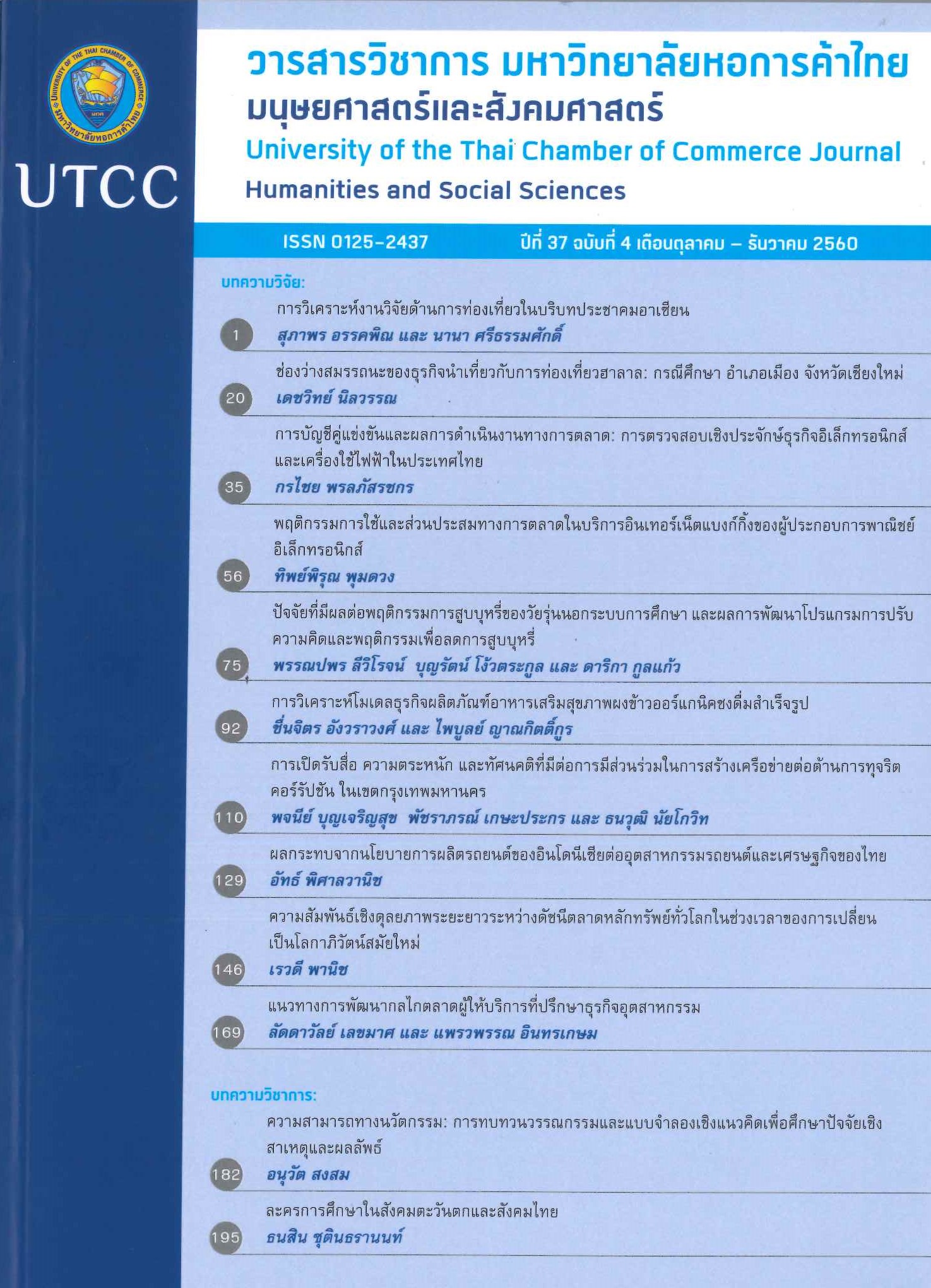An Analysis of Tourism Research in the Context of ASEAN Community
Main Article Content
Abstract
This qualitative research aims to study and analyze tourism research in the context of ASEAN (Association of Southeast Asian Nations). This study is based upon social science research data published from 2008 to 2014. Three aspects of research were analyzed, namely research titles, methods, and analysis trends. Sixty-nine research articles were characterized by a combination of analysis of Content Analysis and Thematic Analysis utilized through the computer software package NVivo10. The study’s results revealed that research on tourism in the context of ASEAN was pursued in a wide range of analysis, for example, the collaboration and competitiveness between the member countries, marketing and branding, management and development, and policy and planning. In terms of the methods used to collect data, all quantitative,
qualitative and mix methods were found. In the case of trends in tourism research in the ASEAN context, it has been forecast and analyzed by the standards of professional proficiency due to the effect of a policy of free-flow skilled labor between the ASEAN member countries.
Article Details
ลิขสิทธิ์ของบทความ
ผลงานที่ได้รับการตีพิมพ์ถือเป็นลิขสิทธิ์ของมหาวิทยาลัยหอการค้าไทย ห้ามมิให้นำเนื้อหา ทัศนะ หรือข้อคิดเห็นใด ๆ ของผลงานไปทำซ้ำ ดัดแปลง หรือเผยแพร่ ไม่ว่าทั้งหมดหรือบางส่วนโดยไม่ได้รับอนุญาตเป็นลายลักษณ์อักษรจากมหาวิทยาลัยหอการค้าไทยก่อน
References
ASEAN tourism agreement. (2015). Retrieved September 4, 2016, from https://asean.org/?static_post=asean-tourismagreement
Berelson, B. (1952). Content analysis in communication research. New York, N.Y.: The Free Press.
Berg, B. L. (2009). Qualitative research methods for the social sciences (7th ed). Boston, M.A: Allyn & Bacon.
Berry, L. L. (1983). Relationship marketing. In L. L. Berry, G. L. Shostack & G.D. Upah (Eds.), Emerging perspectives on services marketing (pp. 25-38). Chicago, IL:American Marketing Association.
Billore, S., Billore, G., & Yamaji, K. (2013). The online corporate branding of banks: A comparative content analysis of Indian and Japanese Banks. Journal of American Business Review, Cambridge,1(2), 90-96.
Braun, V. & Clarke, V. (2006). Using thematic analysis in psychology. Qualitative Research in Psychology, 3(2), 77-101. Retrieved from https://eprints.uwe.ac.uk/11735
Chinese tourists boost Thai economy but stir outrage. (2015, July 5). The Nation. Retrieved from https://www.nationmultimedia.com/news/business/aec/30263782.
Edgell, D. (2013). The essence of understanding issues that portent the future of global tourism. Journal of Hospitality and Tourism, 11(2), 22-29
Edgell, D. (2014). Trinet posting: Ten important world tourism issues for 2015. Tourism Research Information Network. Retrieved July 9, 2016, from https://www.gwutourism.
org/blog/ten-tourism-trends-for-2014/
Government moves to head off tourist fears. (2015, August, 24). Bangkok Post. Retrieved from https://www.bangkokpost.com/print/666028/
Gray, J. H., & Densten, I. L. (1998). Integrating quantitative and qualitative analysis using latent and manifest variables. Quality & Quantity, 32: 419-431.
Hahn, C. (2008). Doing qualitative research using your computer: A practical guide. Retrieved July 9, 2016, from https:// methods.sagepub.com/book/doingqualitative-research-using-your-computer.
Hahn, C. (2008). Doing qualitative research using your computer: A practical guide. London: SAGE Publications.
Lovelock, C., and Gummesson, E. (2004) Whither Services Marketing? In Search of a New Paradigm and Fresh Perspective. Journal of Service Research, 7(1), 20-41.
McCool, S. F., Moisey, R. N. & Nickerson, N. P. (2001) What should tourism sustain? The disconnect with industry perceptions of useful indicators. Journal of Travel Research, 40(2), 124-131.
Merton, R. K. (1968). Social theory and social structure. New York, N.Y.: Free Press.
NVivo10. (n.d.) Retrieved September 8, 2014, from https://www.qsrinternational.com/products_nvivo.aspx.
Parasuraman, A., Zeithaml, V. A. and Berry, L. L. (1994) Reassessment of expectations as a comparison standard in measuring service quality: implications for future research. Journal of Marketing, 58, 111-124.
Pearce, P. L. (2004). Theoretical innovation in Asia Pacific tourism research. Asia Pacific Journal of Tourism Research, 9(1),57-70.
Schuckert, M., Liu X, & Law, R. (2015). Hospitality and tourism online reviews; recent trends and future directions.
Journal of Travel & Tourism Marketing, 32, 608–621. Retrieved from https://www.researchgate.net/publication/264238827_ Hospitality_and_Tourism_Online_Reviews_Recent_Trends_and_Future_Directions
Shoemaker, P. J., & Reese, S. D. (1996).Mediating the message: Theories of influences on mass media content. White Plains, New York, N. Y,: Longman.
Strauss, A. L. (1987). Qualitative analysis for social scientists. New York, N.Y.:Cambridge University Press.
Thematic analysis. (2016) Retrieved July 9,2016, from https://writing.colostate.edu/guides/ pdfs/guide61.pdf
Tolkach, D, Kaye, K. S. C., & Xiao, H. (2016). Asia Pacific tourism trends: Is the future ours to see?. Asia Pacific Journal of Tourism Research, 21(10), 1071-1084.
Tourism Authority of Thailand. (2014). 2013 World Tourism Trends and 2014 forecast. Retrieved September 6, 2014, from https://www.etatjournal.com/web/menuread-web-etatjournal/menu-2014/menu2014-apr-jun/586-22014-trend
United Nations Environment Programme. (2011). Green Economy Tourism. Retrieved July 9, 2016, from https://www.unep.org/ resourceefficiency/Portals/24147/scp/ business/tourism/ greeneconomy_tourism. pdf
United Nations World Tourism Organization. (2010). Tourism and the SDGs (Sustainable Development Goals). Retrieved July 9, 2016, from https://icr.unwto.org/content/tourism-and-sdgs
Vitouladiti, O. (2014). Content analysis as a research tool for marketing, management and development strategies in tourism. Procedia Economics and Finance, 9, 278-287.
Wong, E. P. Y., Mistilis, N., & Dwyer, L. (2011). A model of ASEAN collaboration in tourism. Annals of Tourism Research. 38(3), 882-899.
World Tourism Organisation. (2014). Understanding Tourism: Basic Glossary. Retrieved July 9, 2016, from https://media. unwto.org/en/content/understandingtourism-basic-glossary
World Tourism Organization. (2014). Annual Report 2014. Retrieved from www.e-unwto.org/doi/pdf/10.18111/9789284416226
World Tourism Organization. (2015). UNWTO tourism highlights 2015 edition. Retrieved July 9, 2016, from www.e-unwto.org/doi/pdf/10.18111/9789284416899
World Tourism Organization. (2016). UNWTO tourism highlights 2015 edition. Retrieved July 9, 2016, from www.e-unwto.org/doi/pdf/10.18111/9789284418145
World Travel & Tourism Council. (2015). Travel and tourism, economic impact 2015,Thailand. Retrieved July 9, 2016, from https://www.wttc.org/media/files/reports/
economic%20impact%20research/countries%202015/thailand2015.pdf
Yin, R. K. (2003). Case study research. Design and methods. Retrieved July 9, 2016, from https://www.hampp-ejournals.de/hampp-verlag-services/get?file=/frei/ZfP_1_2012_93


